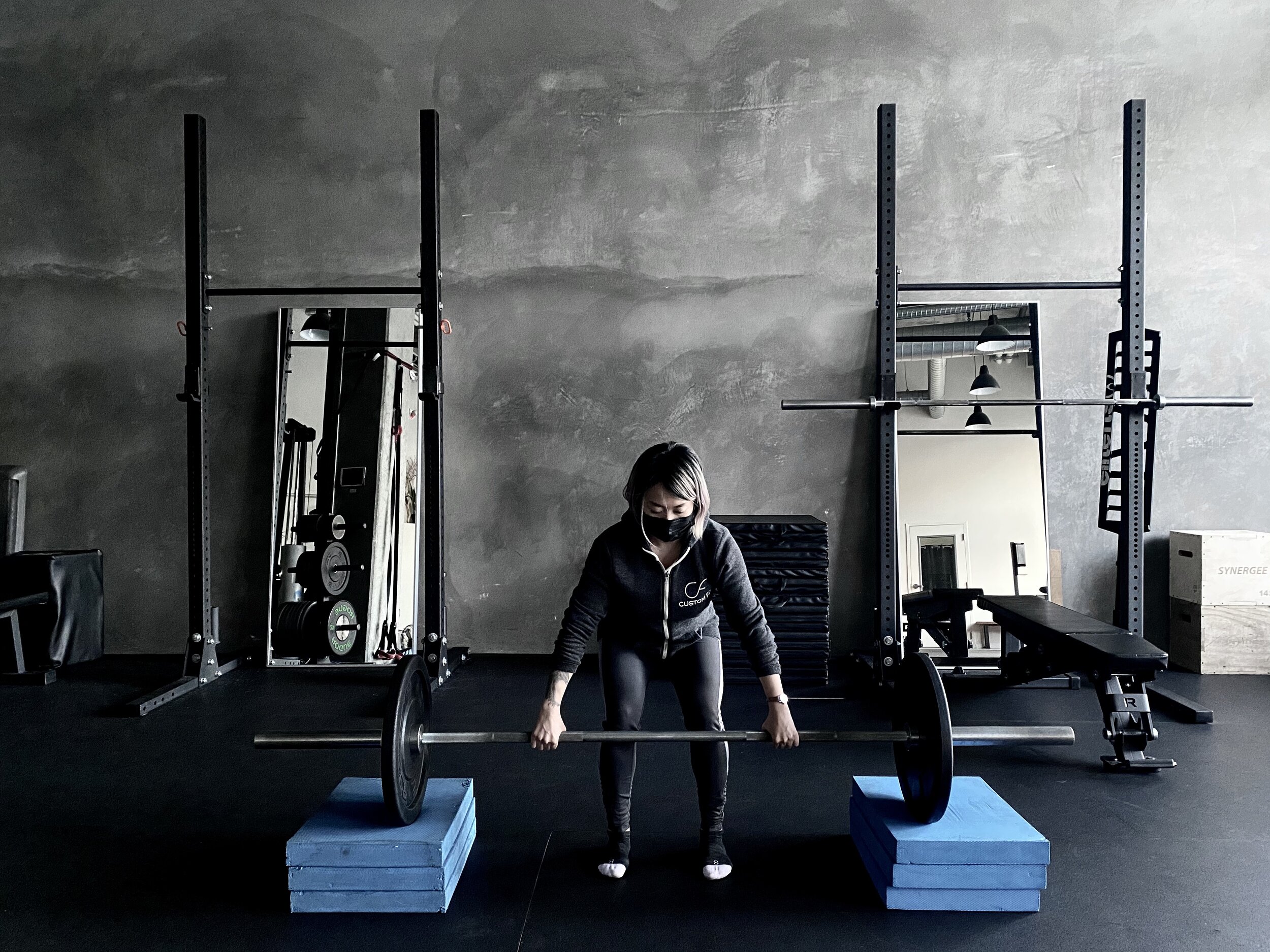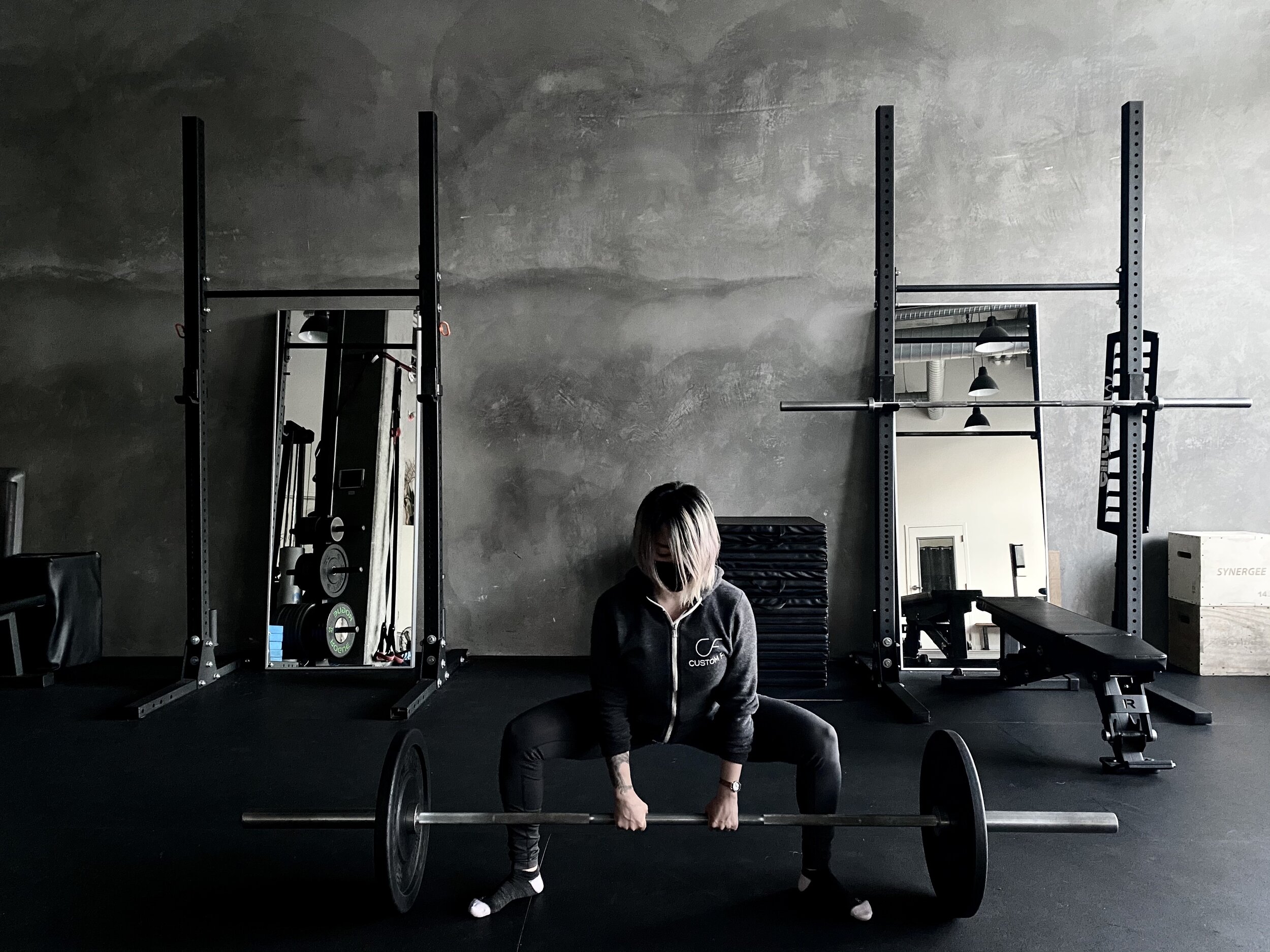Picking up a dead weight from the floor sounds simple enough, but the barbell deadlift is one of the most complex movements to master in the gym. Why? It’s a multi-joint movement requiring significant muscle recruitment, spinal stability, and joint mobility, and mastering this lift means that you’ve optimized force production by integrating movement efficiently between primary, secondary, and synergistic muscles throughout the body. It also means that as you progress with heavier weights, or switch from simpler to more complex variations, you are able to consistently perform with proper technique.
Challenging as it may sound, however, deadlifts can be executed safely and are practical for anyone at any skill level who wants to reap its many benefits (athleticism, strength, functional fitness for daily activities, high calorie-burn, core stability, glute and back development, and improved posture, to name a few). How? By starting with simpler setups and lower resistance levels. In this article, we’re going to cover 6 beginner-friendly variations of the deadlift.
[1] The Block Deadlift
The Block Deadlift is a deadlift variation that shortens the range of motion (ROM) of a conventional deadlift for minimal low back stress and neural adaptation, allowing you to focus on the top portion of the lift while getting used to proper foot stance and holding full-body tension while developing hip flexibility, back stability, and back strength.
There are a few ways a block can be used in a deadlift setup. The easiest variation of the block deadlift is using a single weight (such as a kettlebell or dumbbell) placed on a riser, step, or yoga block, centered between the feet, so that the weight can travel along your midline - closest to your center of gravity. A progression of this exercise would be using a pair of weights stacked on blocks outside the feet. For a barbell variation, blocks can be set up under each plate stack.
This deadlift variation can be programmed with a small amount of weight to start with and progress to more moderate amounts of weight. It can also be partnered with exercises that address any other limiting factors such as hip flexibility, ankle mobility, thoracic mobility, and core strength, before progressing onwards to a deadlift from off the floor.
[2] The Single-Leg Deadlift, or Staggered-Stance “Kickstand” Deadlift
The Single-Leg Deadlift and Staggered-Stance “Kickstand” Deadlift, two slightly different variations of a single-leg deadlift, are not only great ways to improve your overall deadlifting strength, but also can be used to address any left or right-side imbalances or weaknesses and assist with unilateral (single-sided) neural adaptations that must take place to optimize muscle recruitment. This exercise emphasizes core coordination and strengthens the core sling system (shoulder to opposite hip). T
The conventional single-leg deadlift (variation with one leg lifting off the floor) requires core stability, balance, and proprioceptive control as the hip hinges with the torso descending forward to an almost-parallel position with the floor. It can be weighted with a free weight in a contraload position (load on the opposite side), ipsiload position (load on the same side), or bilaterally with two weights. A regression of this setup can allow one hand to use a wall or bench to assist with balance. Alternatively, the exercise may be performed by utilizing a weight with a fixed line of pull, such as a cable machine or a landmine setup, to make it easier to balance. The unique benefit of the single-leg deadlift is the deep stretch resulting from the extreme torso angle, which creates a larger range of motion (ROM).
The Staggered-Stance or “Kickstand” Deadlift is a regressed single-leg deadlift where the back leg stays on the floor. This variation may be used as a prior to advancing to the aforementioned conventional single-leg deadlift.
[3] The Banded Deadlift
The Banded Deadlift variation is a great way to challenge basic hip-hinge form. There are several ways to use bands in the deadlift and each setup has slightly different benefits. A common setup is having a band anchored to the floor (looped around the feet, or connected to hooks or dumbbells), in which the greatest tension lies at the upper part of the lift - where external torque and resistance is typically reduced (since the weight picks up velocity from the bottom part of the lift). The band can easily be used on its own or looped through a kettlebell or dumbbell.
Depending on the anchor points used, areas of tension can be changed. For example, a band that is anchored in front of you instead of below you or at your feet pulls you forward, encouraging shoulder extension and activation of the lats (latissimus dorsi), which are essential for maximizing power and strength in the deadlift. You may choose to experiment with variations of the banded deadlift to enhance activation, neural adaptation, and overall muscular recruitment throughout the lift.
[4] The Sumo Deadlift
The Sumo Deadlift is a unique deadlift variation that uses greater hip external rotation and knee flexion, which engages more of the glute medius, quads (specifically, the vastus medialis and vastus lateralis), and the outside fibers of the calves (tibialis anterior). It also allows for a more upright back position, thus reducing the demand on the low back. Foot stance for this variation is wider than shoulder-width, with toes pointing outwards, allowing the shins to be positioned perpendicular to the floor. The back should be flat, with arms extending downwards between the knees to grasp the weight. In a barbell setup, the shoulders should be aligned above the bar. There is also evidence that shows that lifters with a longer torso relative to leg length may find this variation easier to perform. Due to the wider stance and narrow arm positioning, this deadlift variation shortens the range of motion (ROM), allowing use of heavier loads compared to the conventional deadlift.
[5] The Pause Deadlift
Manipulating tempo in a lift is yet another method of challenging technique and form. The Pause Deadlift, which typically requires a 2-second pause somewhere between the floor and the knees, allows you to address a particular sticking point (difficult part) in the lift by increasing time under tension (TUT).
For example, if your sticking point is getting the weight off the floor, your 2-second pause could be just 1-inch off the floor. If it’s completing the lift at the lock-out position (at the top), your pause may be closer to the knees. The Pause Deadlift is commonly used to reinforce the bottom portion of the lift, engaging more of the muscles involved in knee extension - the quads.
For effective execution of the Pause Deadlift, be consistent with each rep, pausing at the same spot, and focus on moving out of the pause with an explosive effort, so the weight does not descend before ascending again. This variation can be used effectively in place of adding a heavier load.
[6] The Hex Bar Deadlift, aka The Trap Bar Deadlift
The Hex Bar Deadlift, or the Trap Bar Deadlift, is a deadlift variation that incorporates a hexagonal-shaped specialty bar which the lifter steps inside of. This bar also features neutral-grip handles, and often comes with a higher and lower set of handles. Compared to a conventional deadlift, the Hex Bar Deadlift has a decreased range of motion (ROM), allows for a more upright torso position (less stress on the low back), and requires more knee flexion at the bottom portion of the lift (hence more quad-dominant), as is the case with the Sumo Deadlift. It still requires significant posterior chain muscular recruitment, but its demand on the low back and hamstrings is slightly diminished.
Anecdotally, the Hex Bar Deadlift has allowed heavier loads compared to the conventional barbell deadlift. This may be because the hex bar allows the lifter’s center of mass to be aligned more closely to their joints, as Chris Beardsley comments.
Thanks to the introduction of many modern types of gym equipment, as well as the ability to manipulate body position, tension, and tempo, the deadlift can be regressed for anyone at any skill level, and customized to address specific weaknesses or sticking points. As we wrote about in our previous post, the deadlift is a beneficial, functional exercise that works well for both sexes, building strength, muscle tone, and supporting weight loss (specifically, fat loss), and being “old”, “not knowing how to exercise”, or having recovered from a previous injury doesn’t preclude you from benefiting from this essential lift. Give these deadlift variations a try, and see how they improve your technique, mind-body connection, and confidence!
And if you’re still unsure how to go about learning the deadlift, it can be extremely beneficial to work with a coach or personal trainer. Here at Custom Fit SF, we can set you up with your own personal trainer, so you not only have someone teaching it to you one-on-one, with the ideal set up for you, but also a second set of eyes checking your form as you practice - and master - this amazing lift! Whether you’re looking to lose weight, lose body fat, get strong, fit, increase core strength, or put on some muscle (maybe you want that v-taper? or a 🍑 peach-butt?), a trainer can guide you through a customized program that incorporates these important movements. Hit us up and we’ll be happy to help you along your fitness journey!
About Custom Fit SF
Custom Fit SF is San Francisco’s premier personal training facility, with two studios totaling approximately 4,000 square feet. We’re located at 1844 Market Street. We have complimentary towels, a shower, lockers, air conditioning, great music, easy Muni access, street parking, and an incredible amount of natural light. We are never crowded and always clean. We have an arsenal of specialized equipment ready for your personalized program. Come check us out! Fill out the intake form here.
Written By: Christina Lim









